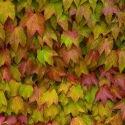Climbers and Vines - Just Arrived
Climbing plants should never be overlooked when you are planning a new garden or revamping an existing planting scheme. They offer so much versatility and with their unique habit they are invaluable for covering up areas of ugliness in your garden that you may wish to keep hidden. Despite their extreme usefulness Climbers should be considered for their graceful nature alone plus the softness they bring to strong architectural lines. Really, what other form of plant gives you more bang for your buck? For just a little space on the ground floor they will cling, twine or scramble with great determination to reach heady heights. Use them to drip through trees, cover archways, soften a fence or wall and cover water tanks or an old tree stump.
CLICK HERE FOR MORE INFORMATION
Pruning a climber or vine in the early stages of its growth is important. As you nip out the growing tips, you encourage the plant to branch out, resulting in many stems that can be trained up the suport. As the climber matures, encourage prolific flowering by pruning, but be aware of the different flowering habits of different plants: some flower on old wood – last season’s growth, and some on new wood – the present season’s growth, so check before you prune. A very important element with regard to pruning is to ensure that you do not cut through a major stem as this will cause a whole section of the plant to die off.
Because a climber is likely to be a permanent fixture in the garden, it is wise to prepare the soil well before planting. Check that the soil is not filled with builder’s rubble as this is often the case next to walls. Include large quantities of organic compost and check that the drainage is good. You are only limited by your imagination. Some climbers such as Trachelospermum jasminoides (AKA Star Jasmine) and Ficus pumila can be used as either a ground cover or small climber depending on how you train the plant initially. Both of these climbers are evergreen. Of equal importance are deciduous climbers such as Clematis and Wisteria which flower in early spring and offer masses of delicate blooms as well as fragrance.
Have a browse through our range of climbers and we are sure you will find a plant that you can easily look up.
CLICK HERE TO CLOSE MORE INFORMATION

CLICK TO ENLARGE
aka Boston Ivy
Boston Ivy - A vigorous climber that will self cling to practically anything by way of creeping tendrils with tiny disc-shaped suckers. The three lobed green foliage turns to spectacular shades of red and purple in autumn. Vigorous and hardy. Deciduous.
Habit: Climbing
Leaves: Deciduous, Green
Mature Size (HxW): 6m x spreads
Leaves: Deciduous, Green
Mature Size (HxW): 6m x spreads
Parthenocissus T Veitchii
Current Stock Height: 10/20 cm ?
Container: 2.5l ?
$39.99
HL Nurseries Limited t/a Wairere Nursery
826 Gordonton Road, R D 1, Hamilton 3281 Ph: (07) 824 3430 Email: